Nissan XTRAIL-NEW-2006 USER Manual
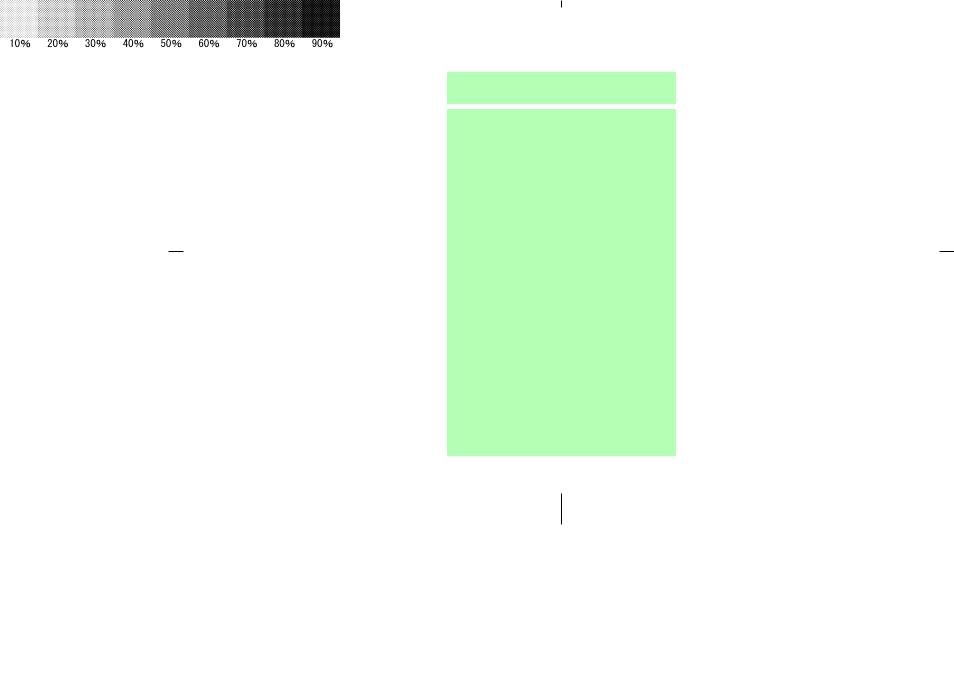
Foreword
Welcome to the growing family of new NISSAN owners. This vehicle is delivered to you with confidence. It was produced using the latest techniques and strict quality control.
This manual was prepared to help you understand the operation and maintenance of your vehicle so that you may enjoy many miles of driving pleasure. Please read through this manual before operating your vehicle.
A separate Warranty Information Booklet explains details about the warranties covering your vehicle. The NISSAN Service and Maintenance Guide explains details about maintaining and servicing your vehicle. Additionally, a separate Customer Care booklet will explain how to resolve any concerns you may have with your vehicle.
A NISSAN dealer knows your vehicle best. When you require any service or have any questions, we will be glad to assist you with the extensive resources available for you.
READ FIRST — THEN DRIVE SAFELY
Before driving your vehicle please read your Owner’s Manual carefully. This will ensure familiarity with controls and maintenance requirements, assisting you in the safe operation of your vehicle.
 WARNING
WARNING
IMPORTANT SAFETY INFORMATION
REMINDERS FOR SAFETY!
Follow these important driving rules to help ensure a safe and comfortable trip for you and your passengers!
Never drive under the influence of alcohol or drugs.
Always observe posted speed limits and never drive too fast for conditions.
Always use your seat belts. Refer to “Child safety” and “Child restraints” in the “ Safety — Seats, seat belts and supplemental restraint system” section for precautions regarding children.
Always provide information about the proper use of vehicle safety features to all occupants of the vehicle.
Always review this Owner’s Manual for important safety information.
MODIFICATION OF YOUR VEHICLE
This vehicle should not be modified. Modification could affect its performance, safety or durability, and may even violate governmental regulations. In addition, damage or performance problems resulting from modification may not be covered under NISSAN warranties.
WHEN READING THE MANUAL
This manual includes information for all options available on this model. Therefore, you may find some information that does not apply to your vehicle.
All information, specifications and illustrations in this manual are those in effect at the time of printing. NISSAN reserves the right to change specifications or design at any time without notice.

IMPORTANT INFORMATION ABOUT THIS MANUAL
You will see various symbols in this manual. They are used in the following ways:
 WARNING
WARNING
This is used to indicate the presence of a hazard that could cause death or serious personal injury. To avoid or reduce the risk, the procedures must be followed precisely.
 CAUTION
CAUTION
This is used to indicate the presence of a hazard that could cause minor or moderate personal injury or damage to your vehicle. To avoid or reduce the risk, the procedures must be followed carefully.
SIC0697
If you see this symbol, it means Do not do this or Do not let this happen.
If you see a symbol similar to these in an illustration, it means the arrow points to the front of the vehicle.
Arrows in an illustration that are similar to these indicate movement or action.
Arrows in an illustration that are similar to these call attention to an item in the illustration.
© 2005 NISSAN MOTOR CO., LTD.
TOKYO, JAPAN
All rights reserved. No part of this Owner’s Manual may be reproduced or stored in a retrieval system, or transmitted in any form, or by any means, electronic, mechanical, photocopying, recording or otherwise, without the prior written permission of Nissan Motor Co., Ltd.
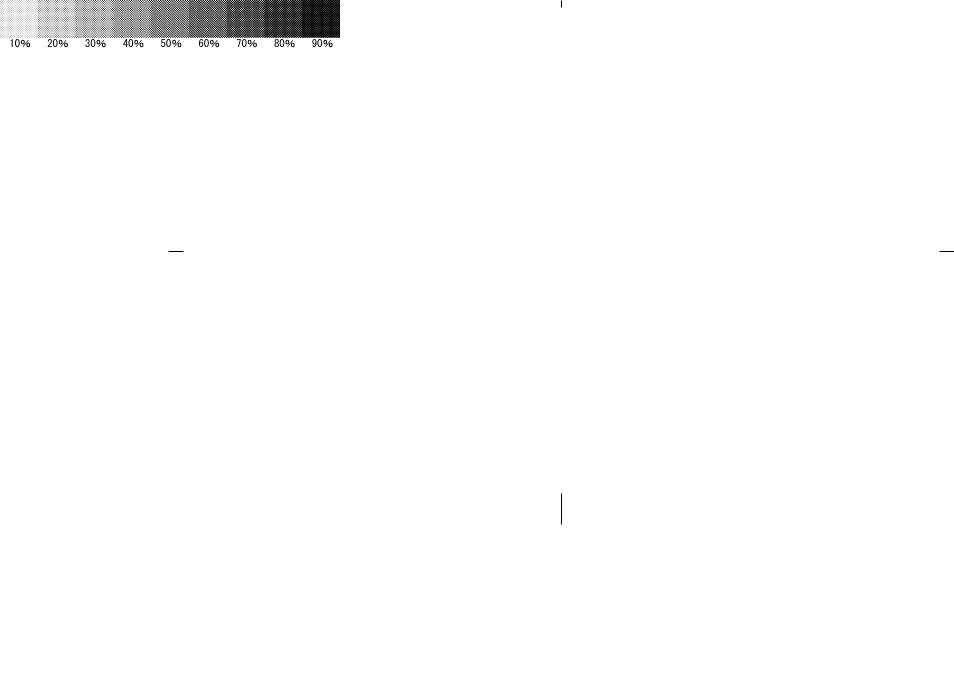
NISSAN CUSTOMER CARE PROGRAM
NISSAN CARES ...
Both NISSAN and a NISSAN dealer are dedicated to serving all your automotive needs. Your satisfaction with your vehicle and a NISSAN dealer are our primary concerns. A NISSAN dealer is always available to assist you with all your automobile sales and service needs.
However, if there is something that a NISSAN dealer cannot assist you with or you would like to provide NISSAN directly with comments or questions, please contact our (NISSAN’s) Consumer Affairs Department using our toll-free number:
1-800-387-0122
The Consumer Affairs Department will ask for the following information:
—Your name, address, and telephone number
—Vehicle identification number (on dash panel)
—Date of purchase
—Current odometer reading
—A NISSAN dealer’s name
—Your comments or questions
OR
You can write to NISSAN with the information on the left at:
Nissan Canada Inc.
5290 Orbitor Drive Mississauga, Ontario L4W 4Z5
We appreciate your interest in NISSAN and thank you for buying a quality NISSAN vehicle.
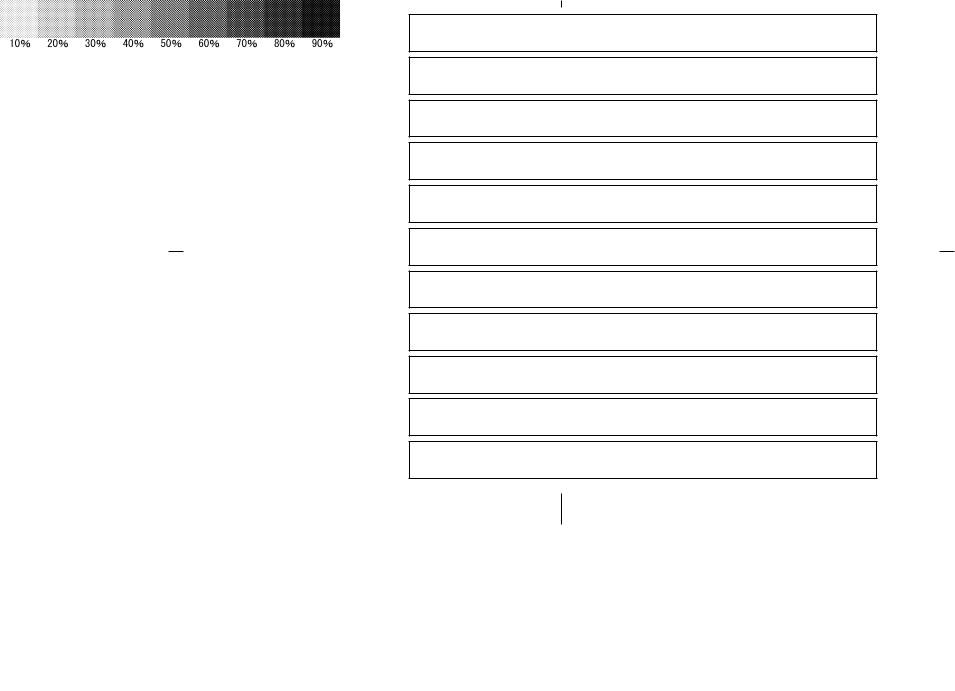
Table of
Contents
Illustrated table of contents
Safety — Seats, seat belts and supplemental restraint system
Instruments and controls
Pre-driving checks and adjustments
Display screen, heater, air conditioner and audio systems
Starting and driving
In case of emergency
Appearance and care
Maintenance and do-it-yourself
Technical and consumer information
Index
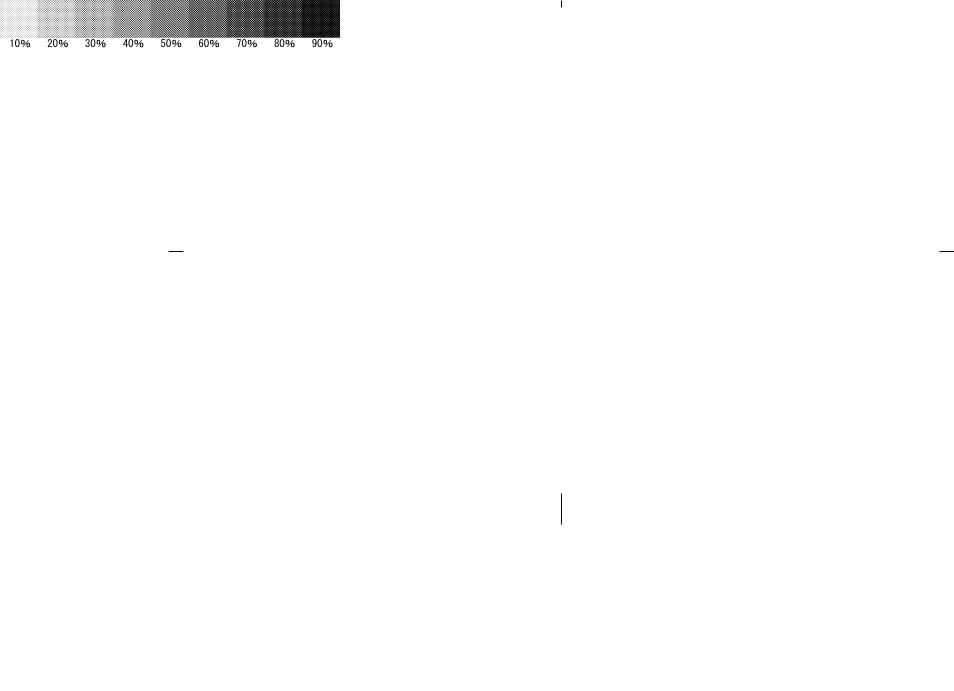
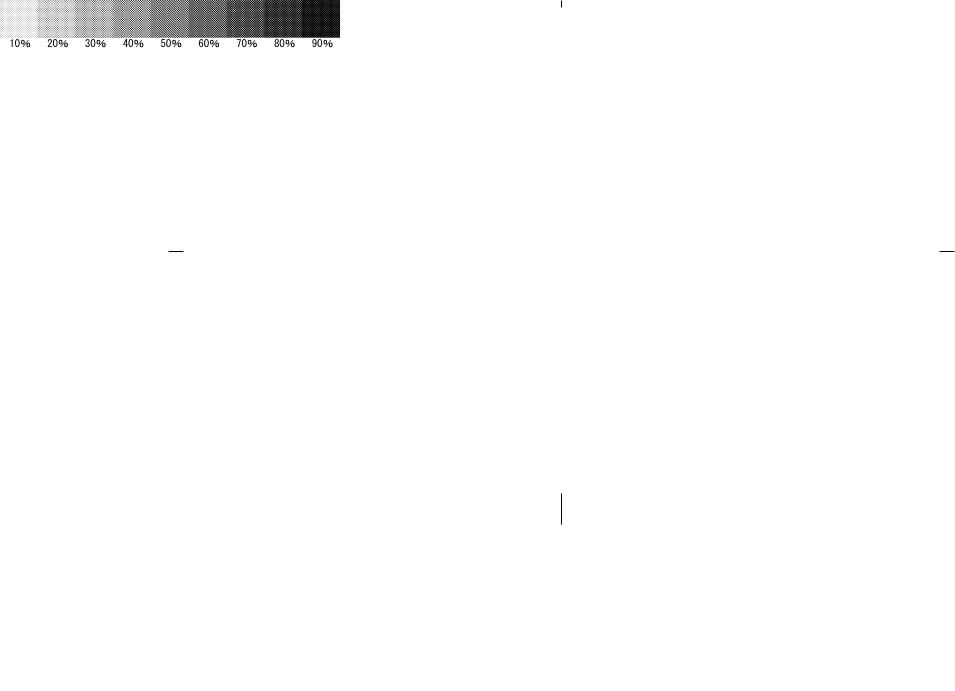
0Illustrated table of contents
Exterior front ........................................................................... |
0-2 |
Exterior rear ............................................................................. |
0-3 |
Passenger compartment ..................................................... |
0-4 |
Instrument panel ................................................................... |
0-5 |
Meters and gauges .............................................................. |
0-7 |
Engine compartment check locations ............................. |
0-8 |
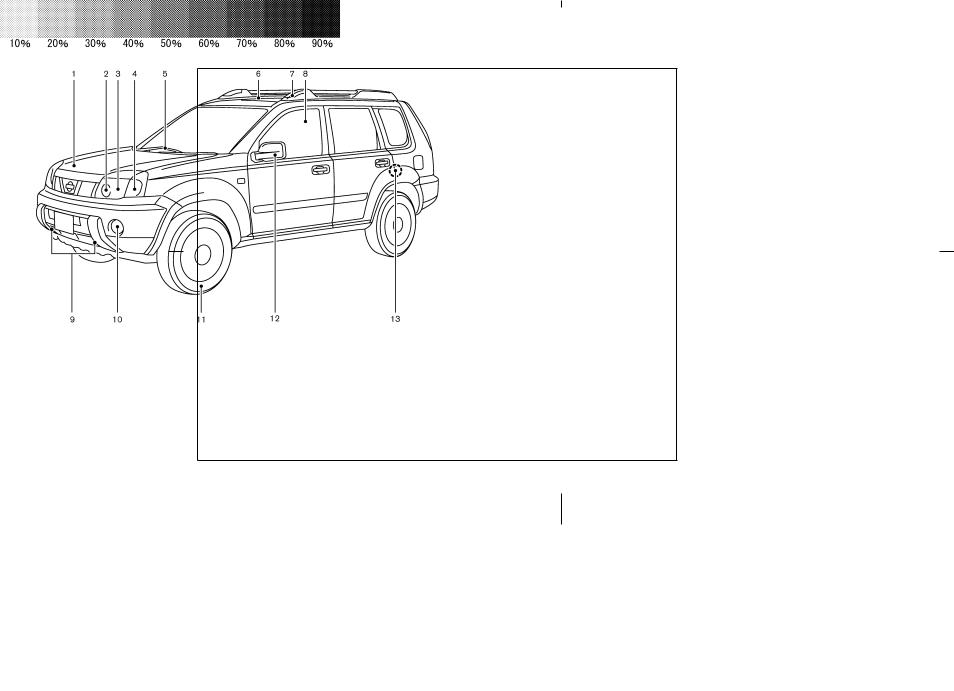
EXTERIOR FRONT
1. Engine hood (Page 3-7)
2. Clearance lights
— Switch (P.2-18)/Bulb (P.8-31) 3. Headlights
— Switch (P.2-18)/Bulb (P.8-27) 4. Turn signal lights
— Switch (P.2-20)/Bulb (P.8-30) 5. Windshield wiper and washer
— Switch (P.2-15)
— Wiper replacement (P.8-20)
— Window washer fluid (P.8-15) 6. Sunroof* (P.2-38)
7. Driving light*
— Switch (P.2-20)/Bulb (P.8-30) 8. Power windows (P.2-36)
9. Recovery hooks (P.6-13)
10. Fog lights*
— Switch (P.2-20)/Bulb (P.8-30) 11. Tires
— Tires and wheels (P.8-34, 9-8)
— Flat tire (P.6-2) 12. Mirrors (P.3-11)
13. Child safety door lock (P.3-4) * If so equipped
SSI0141
0-2 Illustrated table of contents
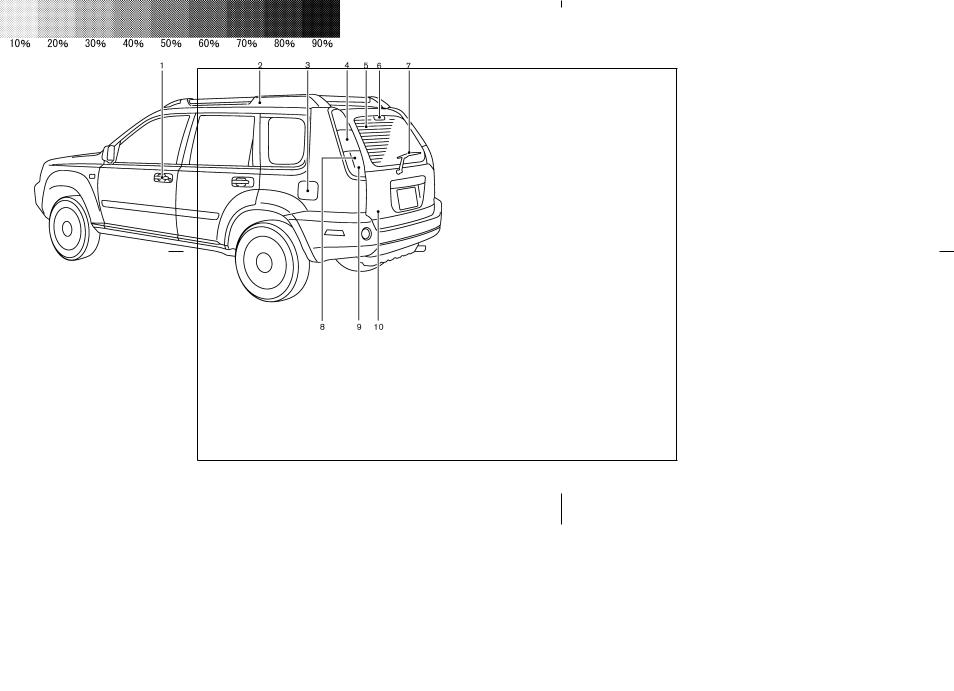
EXTERIOR REAR
1. Doors
— Keys (P.3-2)
— Door locks (P.3-3)
— Remote keyless entry (P.3-5) 2. Roof rail* (P.2-35)
3. Fuel
— Fuel-filler door (P.3-9)
— Fuel recommendation (P.9-3) 4. Stop/tail lights (bulb) (P.8-30) 5. Rear window defogger (P.2-17)
6. High-mounted stop light (bulb) (P.8-30) 7. Rear window wiper and washer (P.2-16) 8. Turn signal lights
— Switch (P.2-20)/Bulb (P.8-30) 9. Back-up light (bulb) (P.8-30) 10. Back door (P.3-7)
* If so equipped
SSI0142
Illustrated table of contents 0-3
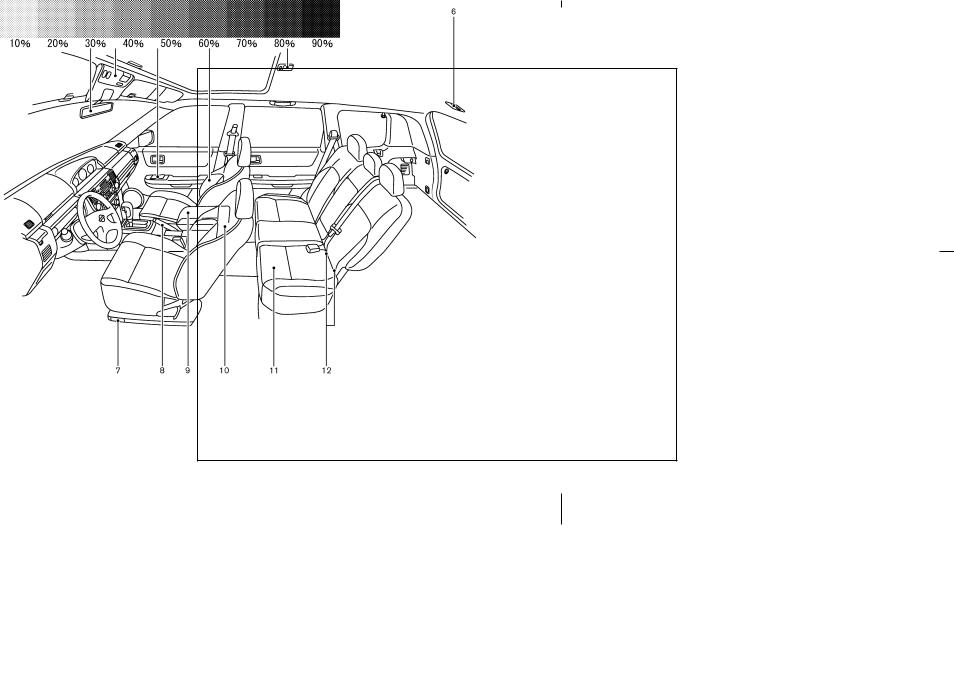
PASSENGER COMPARTMENT
1. Inside mirror (P.3-11)
2. Room light (P.2-39)/Map light (P.2-41) 3. Power windows (P.2-36)
4. Front seat (P.1-2)
5. Room light (P.2-39)
6. Luggage room light (P.2-41)
7. Fuel-filler door opener lever (P.3-9) 8. Parking brake (P.5-15)
9. Console box (P.2-31)
10. Rear cup holders (P.2-29)
11. Rear seat (P.1-6)
12. LATCH system (P.1-26)
SSI0143
0-4 Illustrated table of contents
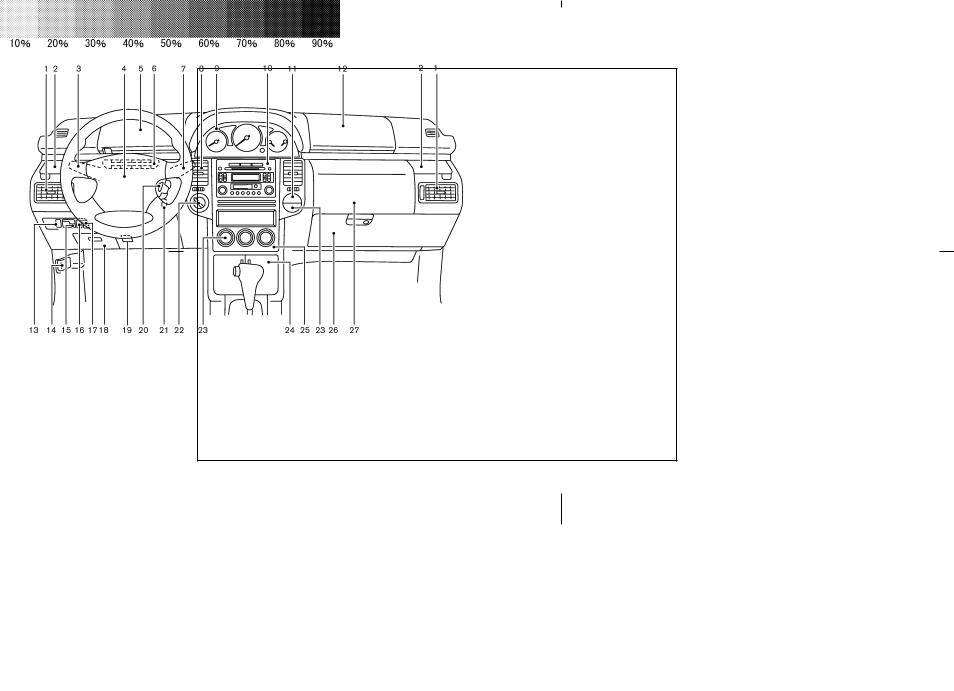
INSTRUMENT PANEL
1. Side ventilator (P.4-7)
2. Cup holder (P.2-28)
3. Headlight/Turn signal switch/Fog light switch* (P.2-18)
4. Driver air bag (P.1-37)/Horn (P.2-22) 5. Driver’s box/Power outlet (P.2-25)
6. Driver’s side ventilator (P.4-7)
7. Wiper and washer switch (P.2-15)
8. Center ventilator (P.4-7)
9. Meters and gauges (P.2-3)
10. Audio system*(P.4-14)/Navigation system**
(P.4-2)
11. Hazard warning flasher switch (P.2-21)
12. Passenger air bag (P.1-37)
13. Driving light switch* (P.2-20)
14. Hood release switch (P.3-7)
15. Outside mirror remote control (P.3-12)
16. Instrument brightness control (P.2-19)
17. VDC (Vehicle dynamic control) off switch*
(P.2-23)
18. Fuse box cover (P.8-22)
19. Tilting steering wheel lock lever (P.3-10)
20. Cruise control switch (P.5-16)
21. Ignition switch (P.5-6)
SSI0144
Illustrated table of contents 0-5
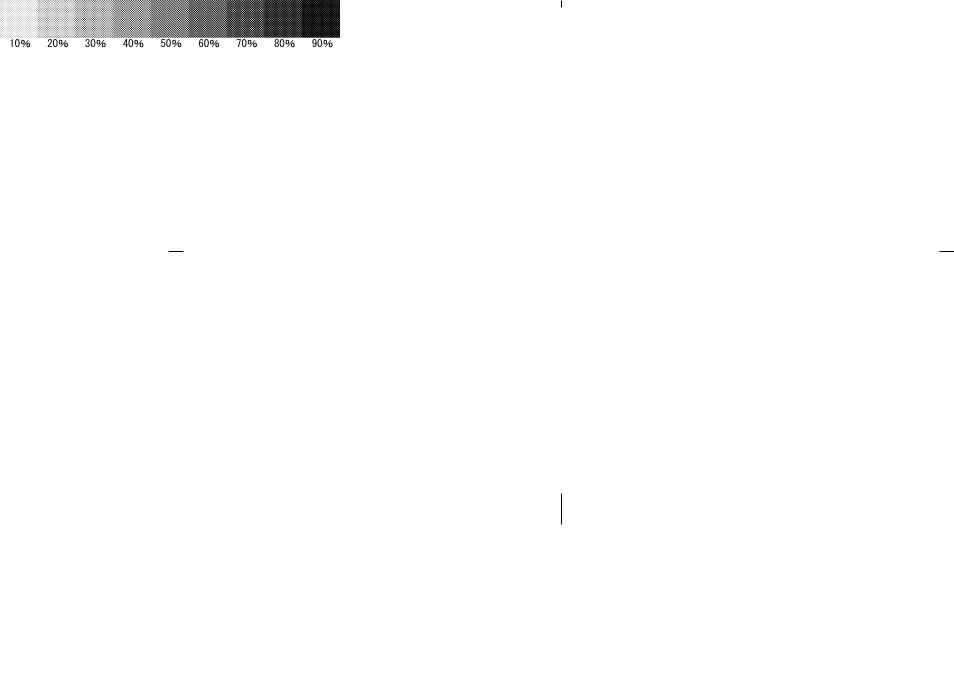
22.4WD mode switch* (P.5-19)/SNOW mode switch* (P.2-23)
23.Rear window/outside mirror defroster switch (P.2-17)
24.Multi box (P.2-27)
25.Heater/air conditioner control (P.4-8)
26.Glove box (P.2-30)
27.Upper glove box (P.2-30)
* If so equipped
**Refer to the separate Navigation System Owner’s Manual
0-6 Illustrated table of contents
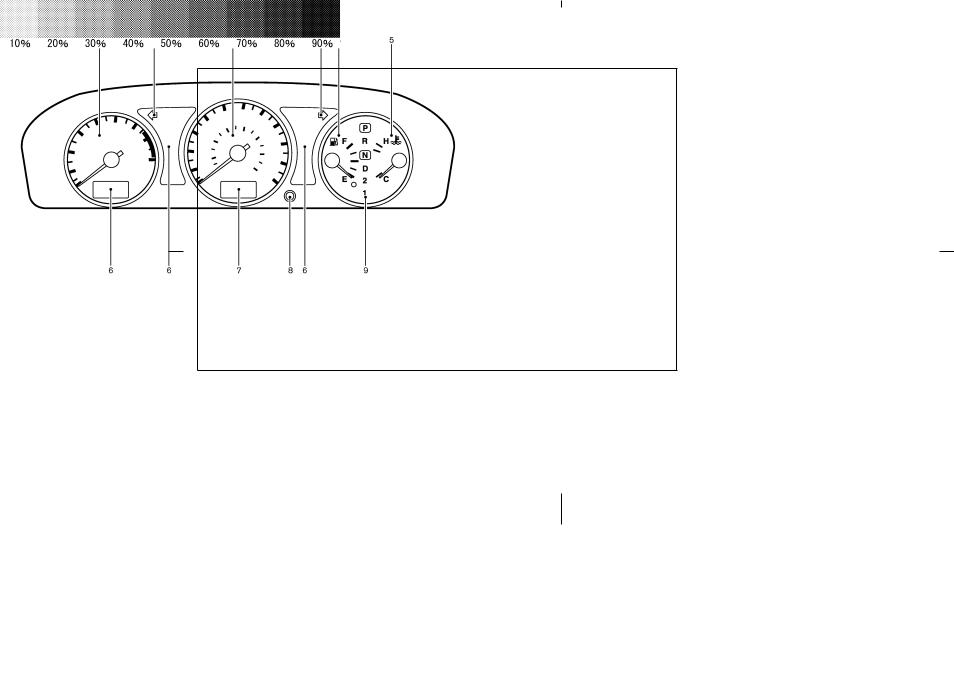
METERS AND GAUGES
1. Tachometer (P.2-5)
2. Turn signal indicator (P.2-20)/Hazard indicator (P.2-21)
3. Speedometer (P.2-4)
4. Fuel gauge (P.2-6)
5. Engine coolant temperature gauge (P.2-5)
6. Warning/Indicator lights (P.2-7)
7. Odometer (Total/Twin trip) (P.2-4)/Clock
(P.2-24)
8. Reset button for trip odometer (P.2-4)/Clock adjustment (P.2-24)
9. Automatic Transmission (AT) shift position indicator* (P.5-10)
* If so equipped
SIC2394
Illustrated table of contents 0-7
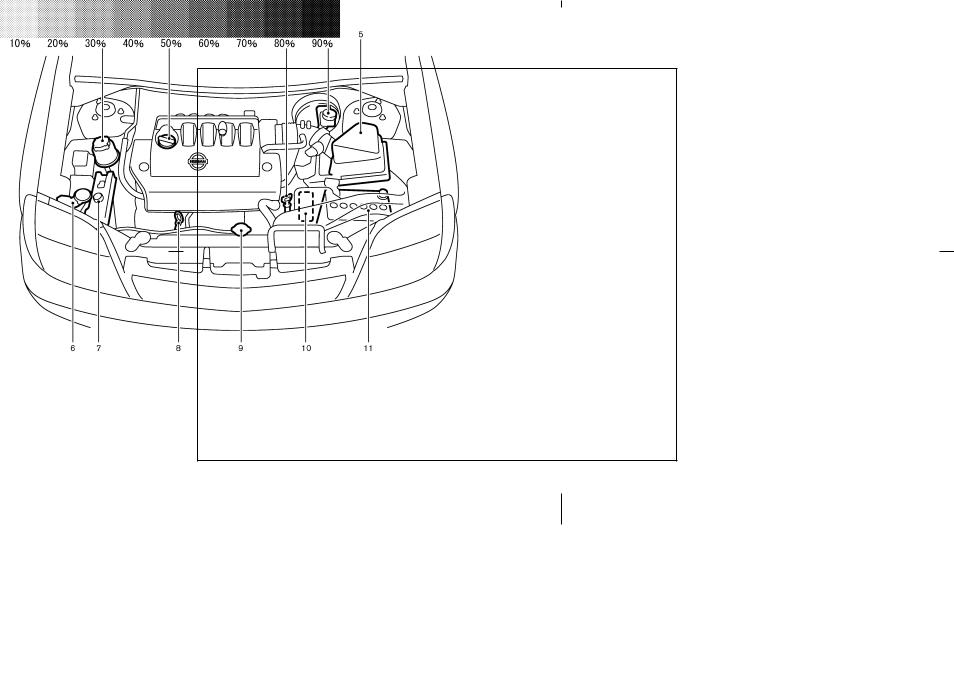
ENGINE COMPARTMENT CHECK LOCATIONS
1. Power steering fluid reservoir (P.8-14)
2. Engine oil filler cap (P.8-11)
3. Automatic transmission fluid dipstick
(*1) (P.8-13)
4. Brake and clutch (*2) fluid reservoir
(P.8-14)
5. Air cleaner (P.8-18)
6. Window washer fluid reservoir (P.8-15)
7. Engine coolant reservoir (P.8-8)
8. Engine oil dipstick (P.8-10)
9. Radiator cap (P.8-9)
10. Fuse/Fusible link holder (P.8-22)
11. Battery (P.8-16)
*1: For Automatic Transmission (AT) model *2: For Manual Transmission (MT) model
SDI1947
0-8 Illustrated table of contents
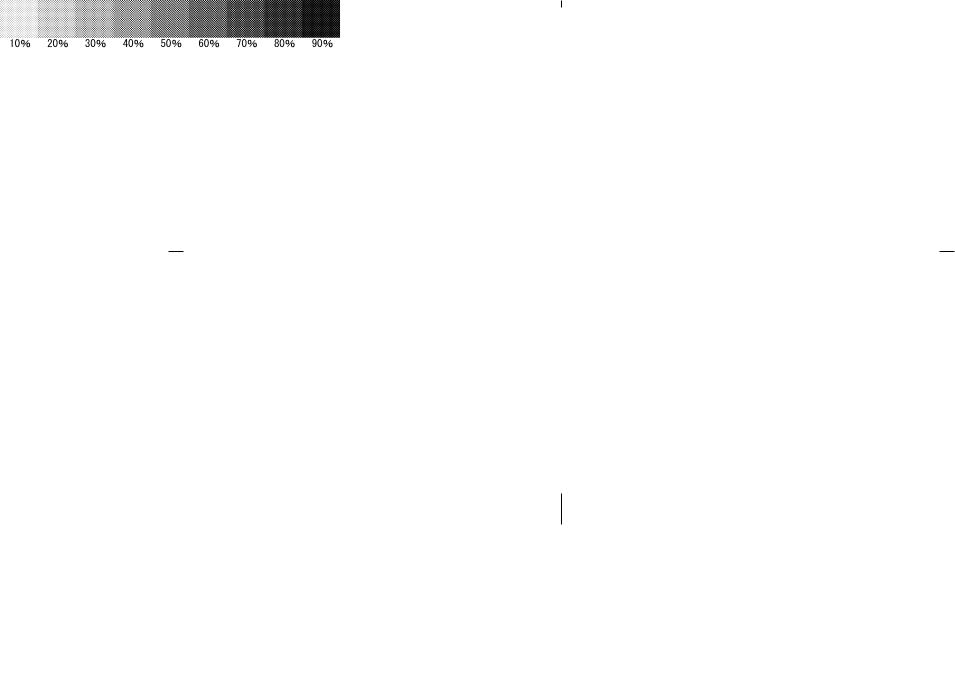
1 Safety — Seats, seat belts and supplemental restraint system
Seats ........................................................................................ |
1-2 |
Front manual seat adjustment ..................................... |
1-2 |
Lumbar support (for driver’s seat) .............................. |
1-4 |
Front power seat adjustment (if so equipped for |
|
driver’s seat) ..................................................................... |
1-4 |
Rear seat adjustment ..................................................... |
1-6 |
Head restraint adjustment (for front seats) ............... |
1-9 |
Active head restraint (for front seats) ..................... |
1-10 |
Armrest ........................................................................... |
1-10 |
Seat belts ............................................................................. |
1-11 |
Precautions on seat belt usage ................................ |
1-11 |
Child safety .................................................................... |
1-14 |
Pregnant women .......................................................... |
1-15 |
Injured persons ............................................................. |
1-15 |
Three-point type seat belt with retractor ............... |
1-15 |
Rear center seat belt .................................................. |
1-19 |
Seat belt extenders ...................................................... |
1-19 |
Seat belt maintenance ................................................ |
1-19 |
Child restraints ................................................................... |
1-20 |
Precautions on child restraints ................................. |
1-20 |
Child restraint installation on rear seat center or |
|
outboard positions ....................................................... |
1-21 |
LATCH (Lower Anchors and Tethers for |
|
CHildren) system .......................................................... |
1-26 |
Top tether strap child restraint ................................. |
1-28 |
Child restraint installation on front passenger |
|
seat .................................................................................. |
1-29 |
Booster seats ....................................................................... |
1-32 |
Precautions on booster seats .................................... |
1-32 |
Booster seat installation on rear seat outboard |
|
or center positions ........................................................ |
1-35 |
Booster seat installation on front passenger |
|
seat.................................................................................... |
1-36 |
Supplemental restraint system ....................................... |
1-37 |
Precautions on supplemental restraint system ..... |
1-37 |
Supplemental air bag warning labels ...................... |
1-47 |
Supplemental air bag warning light ......................... |
1-47 |
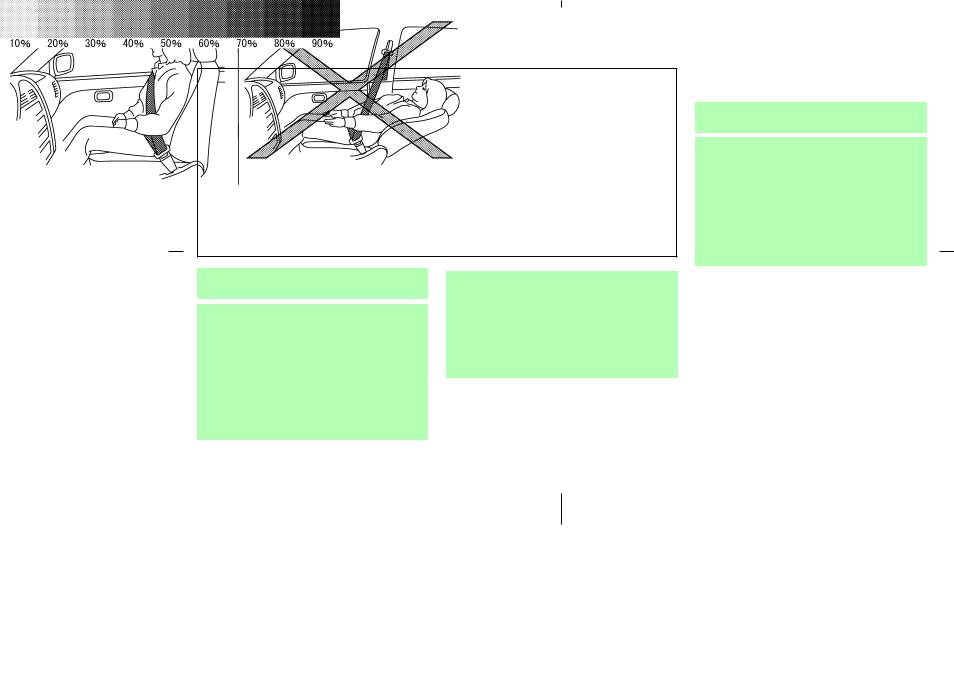
SEATS
SSS0133B
 WARNING
WARNING
Do not ride in a moving vehicle when the seatback is reclined. This can be dangerous. The shoulder belt will not be against your body. In an accident you could be thrown into it and receive neck or other serious injuries. You could also slide under the lap belt and receive serious internal injuries.
For the most effective protection when the vehicle is in motion, the seat should be upright. Always sit well back in the seat and adjust the seat belt properly. See “Precautions on seat belt usage” later in this section.
FRONT MANUAL SEAT
ADJUSTMENT
 WARNING
WARNING
Do not adjust the driver’s seat while driving so full attention may be given to vehicle operation. The seat may move suddenly and could cause loss of control of the vehicle.
After adjustment, gently rock in the seat to make sure it is securely locked.
1-2 Safety — Seats, seat belts and supplemental restraint system
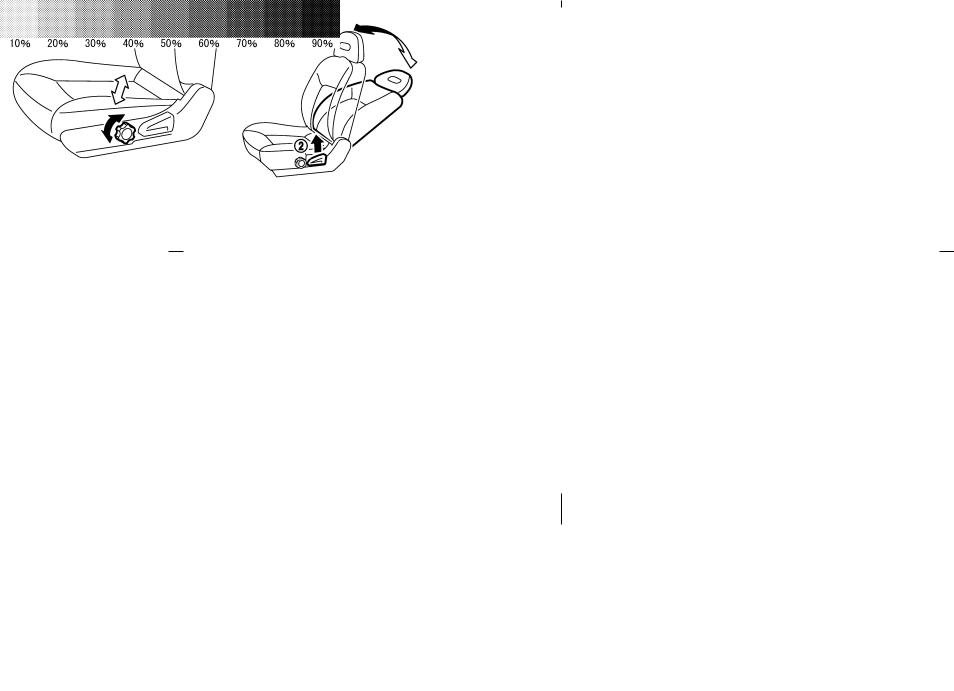
|
|
|
SPA1727A |
|
SSS0344 |
Forward and backward |
Reclining |
Seat lifter (for driver’s seat) |
|||
Pull the lever up |
|
while you slide the seat |
|
Turn the dial and adjust the angle and height of |
|
1 |
To recline the seatback, pull the lever up 2 and |
||||
forward or backward to the desired position. |
lean back. To bring the seatback forward again, |
the seat cushion to the desired position. |
|||
Release the lever to lock the seat in position. |
pull the lever and move your body forward. The |
|
|||
seatback moves forward.
The reclining feature allows adjustment of the seatback for occupants of different sizes to help obtain proper seat belt fit. See “Precautions on seat belt usage” later in this section. The seatback may also be reclined to allow occupants to rest when the vehicle is parked.
Safety — Seats, seat belts and supplemental restraint system 1-3
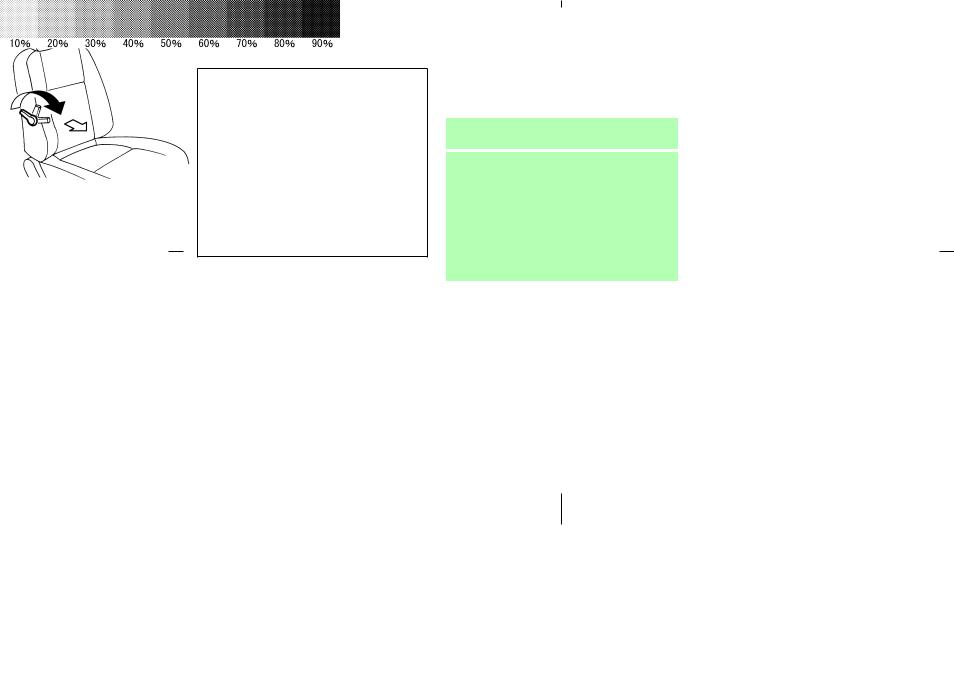
SPA1729A
LUMBAR SUPPORT (for driver’s seat)
The lumbar support feature provides lower back support to the driver.
Turn the lever forward or backward to adjust the seat lumbar area.
FRONT POWER SEAT ADJUSTMENT (if so equipped for driver’s seat)
 WARNING
WARNING
Do not adjust the driver’s seat while driving so full attention may be given to vehicle operation.
Do not leave children unattended inside the vehicle. They could unknowingly activate switches or controls. Unattended children could become involved in serious accidents.
Operating tips
The seat motor has an auto-reset overload protection circuit. If the motor stops during operation, wait 30 seconds, then reactivate the switch.
Do not operate the power support seat for a long period of time when the engine is off. This will discharge the battery.
1-4 Safety — Seats, seat belts and supplemental restraint system
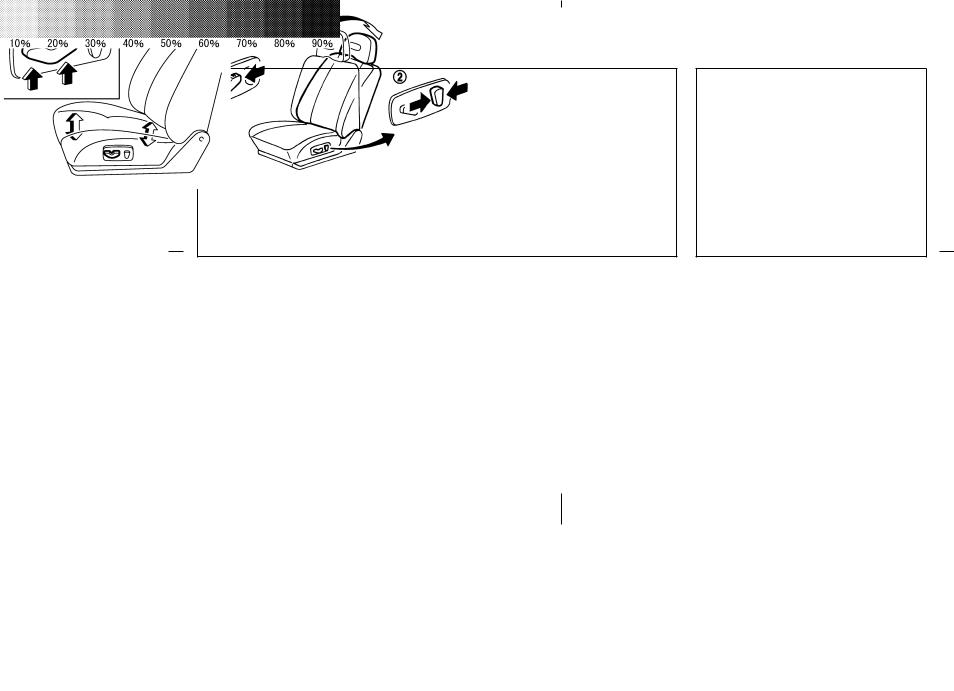
SPA1728A
Forward and backward
Moving the switch 1 forward or backward will slide the seat forward or backward to the desired position.
Reclining
Move the recline switch 2 backward until the desired angle is obtained. To bring the seatback forward again, move the switch forward and move your body forward. The seatback will move forward.
The reclining feature allows adjustment of the seatback for occupants of different sizes to help obtain proper seat belt fit. See “Precautions on seat belt usage” later in this section. The seatback may also be reclined to allow occupants to rest when the vehicle is parked.
SSS0166C
Seat lifter
Push the front or rear end of the switch 1 up or down to adjust the angle and height of the seat cushion.
Safety — Seats, seat belts and supplemental restraint system 1-5
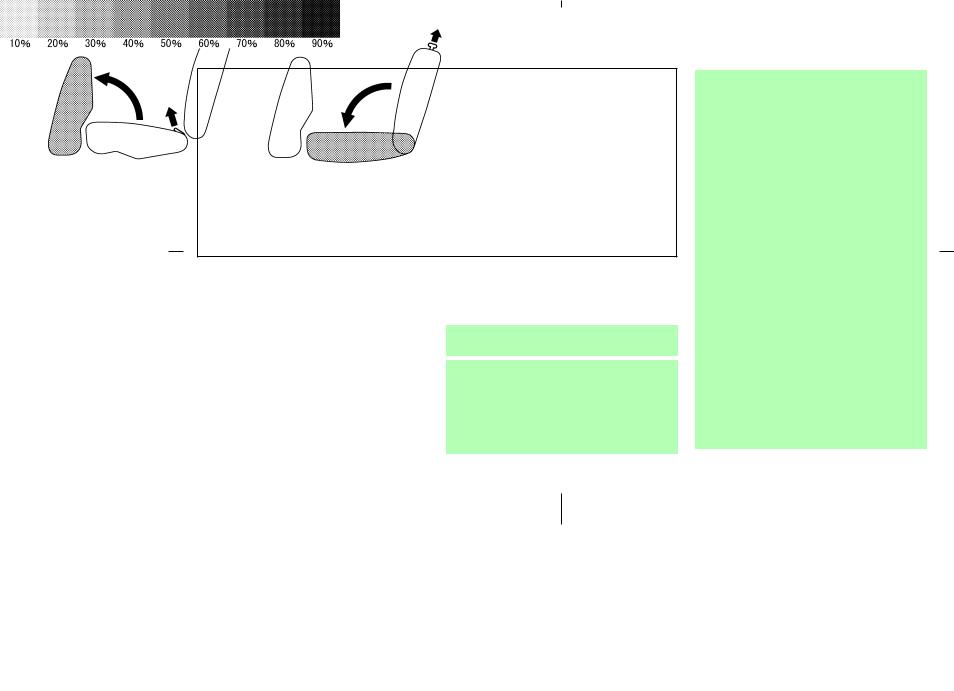
SPA1348A
REAR SEAT ADJUSTMENT
Folding
1.Store the rear cup holder in the center console.
2.Secure the seat belt on the clip.
3.Remove the head restraints. (The removed head restraints can be stored on the reclining lock plate.)
4.Pull the strap forward and bring up the seat cushion 1 .
5.After removing the tonneau cover (if so
equipped) from each rear seatback, pull up the knob and fold the seatback down 2 .
6.When resetting the seat, be sure to hold the seat belt buckles so that they do not fall between the seatback and the seat cushion and install the head restraints.
 WARNING
WARNING
Never allow anyone to ride in the cargo area or on the rear seat when it is in the fold-down position. Use of these areas by passengers without proper restraints could result in serious injury in an accident or sudden
1-6 Safety — Seats, seat belts and supplemental restraint system
stop.
It is extremely dangerous to ride in a cargo area inside of a vehicle. In a collision, people riding in these areas are more likely to be seriously injured or killed.
Do not allow people to ride in any area of your vehicle that is not
equipped with seats and seat belts. Be sure everyone in your vehicle is in a seat and using a seat belt properly.
Do not fold down the rear seats when occupants are in the rear seat area or any luggage is on the rear seat.
Head restraints should be adjusted properly as they may provide significant protection against injury in an accident. Always replace and adjust them properly if they have been removed for any reason.
If the head restraints are removed for any reason, they should be securely stored to prevent them from causing

injury to passengers or damage to the vehicle in case of sudden braking or an accident.
Properly secure all cargo to help prevent it from sliding or shifting. Do not place cargo higher than the seatbacks. In a sudden stop or collision, unsecured cargo could cause personal injury.
When returning the seatbacks to the upright position, be certain they are completely secured in the latched position. If they are not completely secured, passengers may be injured in an accident or sudden stop.
SPA1349A
Reclining
Pull the knob 1 to remove it from the lock plate and lean back until the desired angle is obtained. To bring the seatback forward, pull the knob and move your body forward.
The reclining feature allows adjustment of the seatback for occupants of different sizes to help obtain proper seat belt fit. (See “Precautions on seat belt usage” later in this section.) The seatback may also be reclined to allow occupants to rest when the vehicle is parked.
 WARNING
WARNING
Do not ride in a moving vehicle when the seatback is reclined. This can be dangerous. The shoulder belt will not be against your body. In an accident you could be thrown into it and receive neck or other serious injuries. You could also slide under the lap belt and receive serious internal injuries.
For the most effective protection when the vehicle is in motion, the seat should be upright. Always sit well back in the seat and adjust the seat belt properly. See “PRECAUTIONS ON SEAT BELT USAGE” later in this section.
After adjustment, check to be sure the seat is securely locked.
Safety — Seats, seat belts and supplemental restraint system 1-7
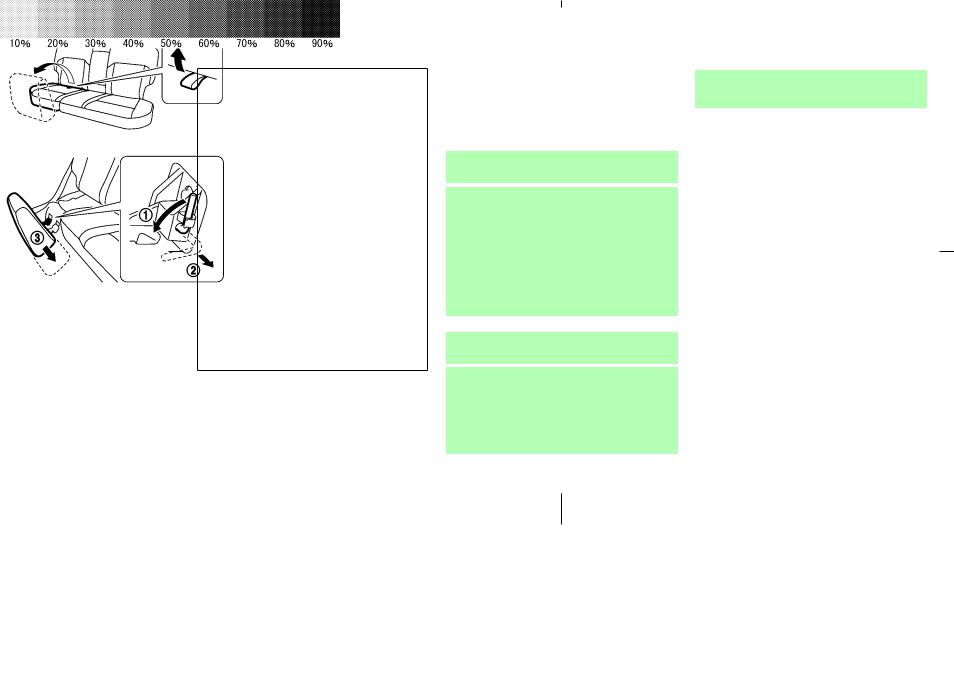
SPA1353
Removing cushion:
The seat cushion can be removed.
1.Pull the strap to bring up the seat cushion.
2.Push down the pin 1 on the hinge.
3.Pull the pin to the direction indicated by the arrow 2 .
4.Remove the seat cushion 3 .
Perform the above steps in reverse order to install the cushion.
 WARNING
WARNING
Do not remove the cushion while driving.
Never allow anyone to ride in the rear seat when the cushion is removed. Use of the seat by passengers without proper restraints could result in serious injury in an accident or sudden stop.
 CAUTION
CAUTION
Store the removed cushion in the luggage area or a secure place.
Be sure to install the pin and firmly set it to the original position when resetting the cushion.
1-8 Safety — Seats, seat belts and supplemental restraint system
Be careful not to pinch hands or feet when resetting the cushion.
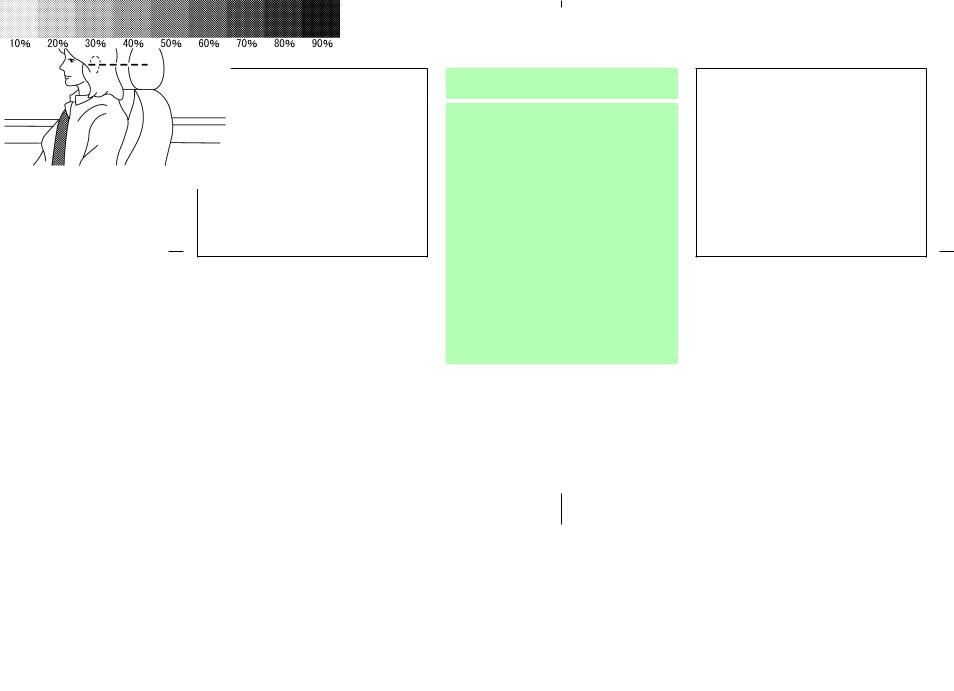
SSS0288
HEAD RESTRAINT ADJUSTMENT (for front seats)
To raise the head restraint, just pull it up. To lower, push the lock knob 1 and push the head restraint down.
When removing the rear head restraint for seat folding etc., push the lock knob and pull up the head restraint. The removed head restraint should be securely stored.
 WARNING
WARNING
Head restraints should be adjusted properly as they may provide significant protection against injury in an accident. Check the adjustment after someone else uses the seat.
Do not remove the head restraints except when folding down the rear seat or using certain child restraints. Always replace and adjust them properly if they have been removed for any reason.
If the head restraints are removed for any reason, they should be securely stored to prevent them from causing injury to passengers or damage to the vehicle in case of sudden braking or an accident.
SSS0287
Adjust the head restraints so the center is level with the center of your ears.
Safety — Seats, seat belts and supplemental restraint system 1-9
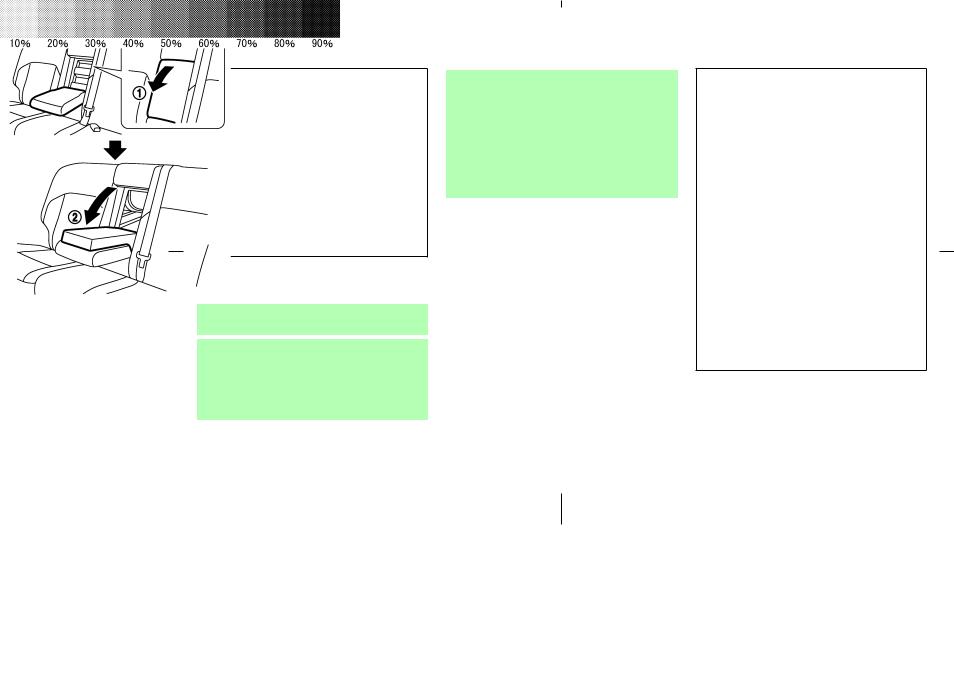
SSS0508
ACTIVE HEAD RESTRAINT (for front seats)
 WARNING
WARNING
Always adjust the head restraints properly as specified in the previous section. Failure to do so can reduce the effectiveness of the active head restraint.
Active head restraints are designed to supplement other safety systems. Always wear seat belts. No system can prevent all injuries in any accident.
Do not attach anything to the head restraint stalks. Doing so could impair active head restraint function.
The head restraint moves forward utilizing the force that the seatback receives from the occupant in a rear-end collision. The movement of the head restraint helps support the occupant’s head by reducing its backward movement and helping absorb some of the forces that may lead to whiplash type injuries.
Active head restraints are effective for collisions at low to medium speeds in which it is said that whiplash injury occurs most.
Active head restraints operate only in certain rear-end collisions. After the collision, the head restraints return to their original positions.
Properly adjust the active head restraints as described in the previous section.
1-10 Safety — Seats, seat belts and supplemental restraint system
SPA1350A
ARMREST
Fold down 1 until the seatback becomes horizontal.
Pull down the pocket 2 to access the luggage area.
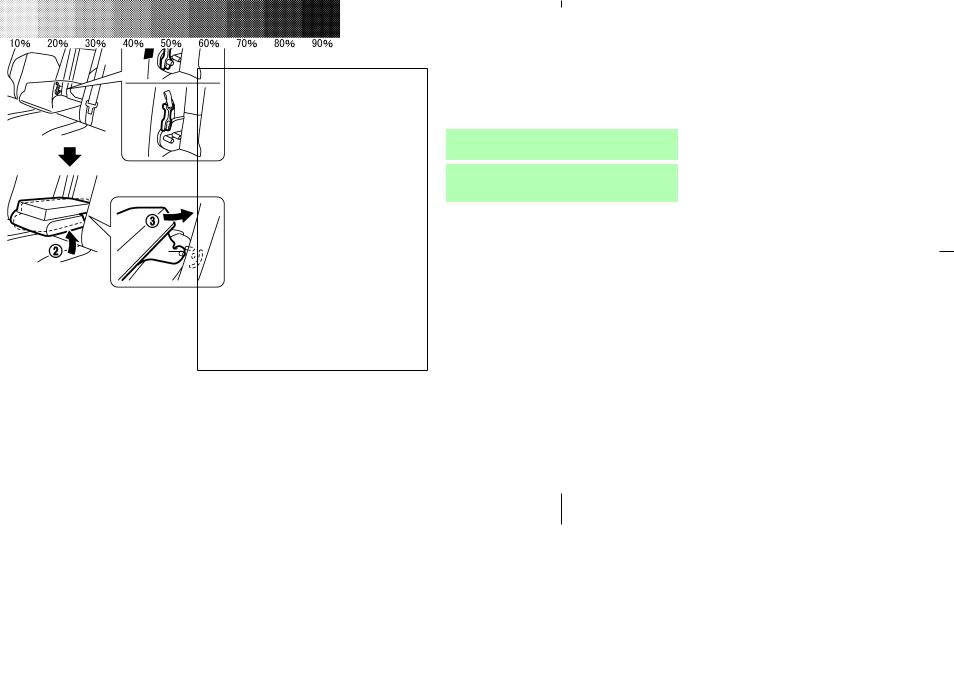
3.Slide the armrest and pocket toward the clip side.
4.Shift the armrest and pocket 2 , sliding them to the right side 3 to remove from the pin.
 CAUTION
CAUTION
Do not sit in the rear center seat position when the armrest is removed.
SPA1354B
SEAT BELTS
PRECAUTIONS ON SEAT BELT USAGE
If you are wearing your seat belt properly adjusted and you are sitting upright and well back in your seat, your chances of being injured or killed in an accident and/or the severity of injury may be greatly reduced. NISSAN strongly encourages you and all of your passengers to buckle up every time you drive, even if your seating position includes a supplemental air bag.
Most states, provinces or territories require that seat belts be worn at all times when a vehicle is being driven.
Removing the armrest
The armrest can be removed.
1.Pull down the seatback and the pocket.
2.Remove the clip 1 from the hinge.
Safety — Seats, seat belts and supplemental restraint system 1-11

SSS0134A
 WARNING
WARNING
Every person who drives or rides in this vehicle should use a seat belt at all times. Children should be properly restrained in the rear seat and, if appropriate, in a child restraint.
The seat belt should be properly adjusted to a snug fit. Failure to do so may reduce the effectiveness of the entire restraint system and increase
the chance or severity of injury in an accident. Serious injury or death can occur if the seat belt is not worn properly.
Always route the shoulder belt over your shoulder and across your chest. Never run the belt behind your back under your arm or across your neck. The belt should be away from your face and neck, but not falling off your shoulder.
1-12 Safety — Seats, seat belts and supplemental restraint system
Position the lap belt as low and snug as possible AROUND THE HIPS, NOT THE WAIST. A lap belt worn too high could increase the risk of internal injuries in an accident.
Be sure the seat belt tongue is securely fastened to the proper buckle.
Do not wear the belt inside out or twisted. Doing so may reduce its effectiveness.
Do not allow more than one person to use the same belt.
Never carry more people in the vehicle than there are seat belts.
If the seat belt warning light glows continuously while the ignition is turned ON with all doors closed and all seat belts fastened, it may indicate a malfunction in the system. Have the system checked by a NISSAN dealer.
Once the pre-tensioner seat belt has activated, it cannot be reused and must be replaced together with the
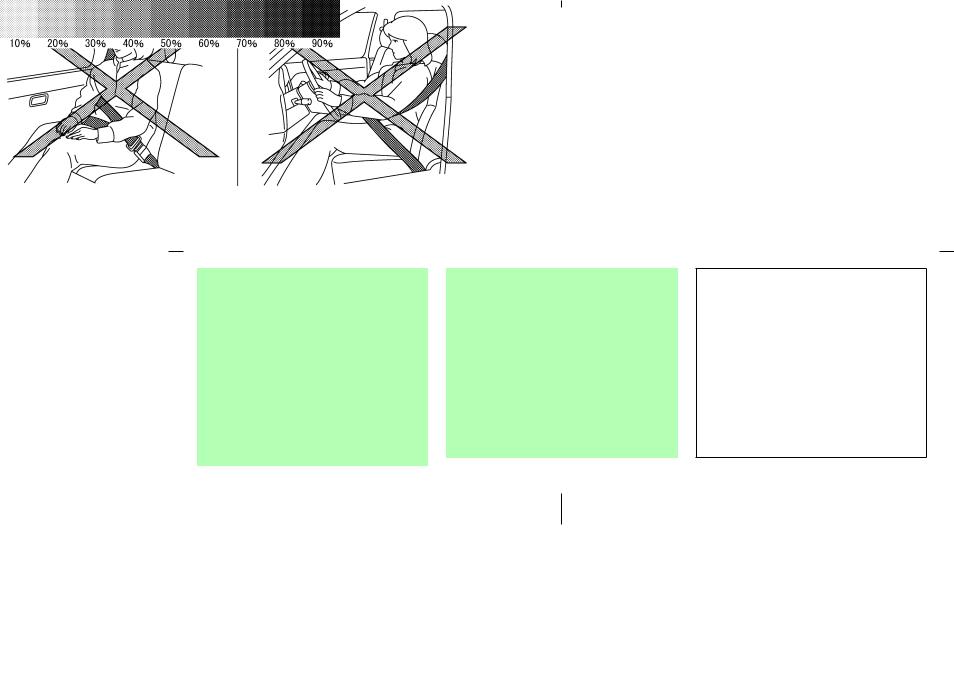
SSS0136A |
|
SSS0016 |
retractor. See a NISSAN dealer.
Removal and installation of the pretensioner seat belt system components should be done by a NISSAN dealer.
All seat belt assemblies including retractors and attaching hardware should be inspected after any collision by a NISSAN dealer. NISSAN recommends that all seat belt assemblies in use during a collision be replaced unless the collision was minor and the belts show no damage
and continue to operate properly. Seat belt assemblies not in use during a collision should also be inspected and replaced if either damage or improper operation is noted.
All child restraints and attaching hardware should be inspected after any collision. Always follow the restraint manufacturer’s inspection instructions and replacement recommendations. The child restraints should be replaced if they are dam-
aged. |
SSS0014 |
Safety — Seats, seat belts and supplemental restraint system 1-13
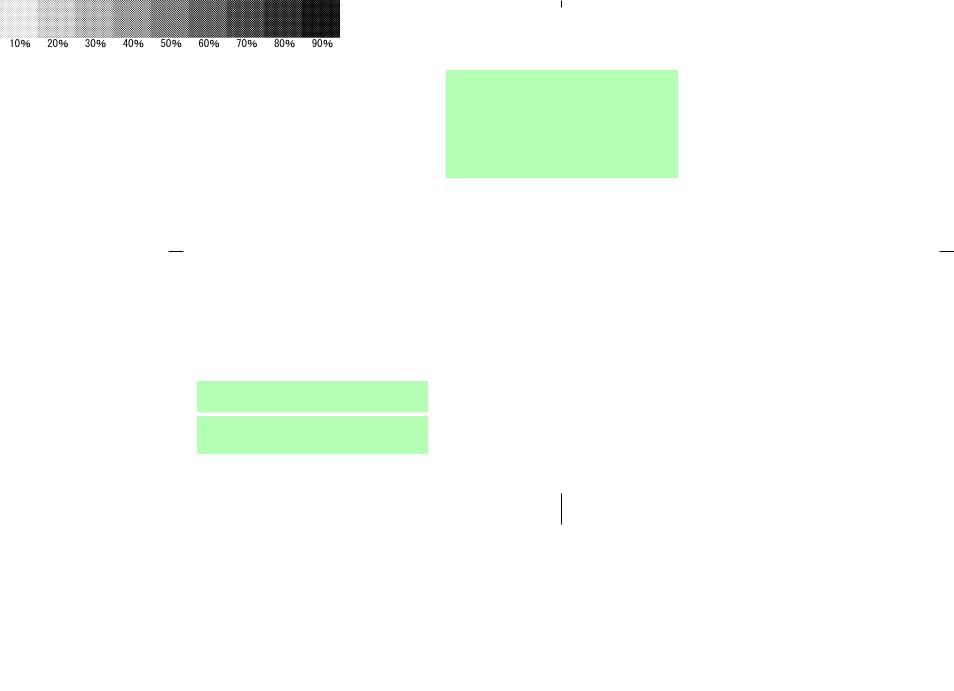
CHILD SAFETY
Children need adults to help protect them. They need to be properly restrained.
In addition to the general information in this manual, child safety information is available from many other sources, including doctors, teachers, government traffic safety offices, and community organizations. Every child is different, so be sure to learn the best way to transport your child.
There are three basic types of child restraint systems:
Rear facing child restraint
Front facing child restraint
Booster seat
The proper restraint depends on the child’s size. Generally, infants (up to about 1 year and less than 9 kg (20 lb) should be placed in rear facing child restraints. Front facing child restraints are available for children who outgrow rear facing child restraints.
 WARNING
WARNING
Infants and children need special protection. The vehicle’s seat belts may not
fit them properly. The shoulder belt may come too close to the face or neck. The lap belt may not fit over their small hip bones. In an accident, an improperly fitting seat belt could cause serious or fatal injury. Always use appropriate child restraints.
All U.S. states and Canadian provinces or territories require the use of approved child restraints for infants and small children. (See “Child restraints” later in this section.)
Also, there are other types of child restraints available for larger children for additional protection.
NISSAN recommends that all pre-teens and children be restrained in the rear seat. According to accident statistics, children are safer when properly restrained in the rear seat than in the front seat. This is especially important because your vehicle has a supplemental restraint system (air bag system) for the front passenger. See “Supplemental restraint system” later in this section.
1-14 Safety — Seats, seat belts and supplemental restraint system
Infants
Infants up to at least one year old should be placed in a rear facing child restraint. NISSAN recommends that infants be placed in child restraints that comply with Federal Motor Vehicle Safety Standards or Canadian Motor Vehicle Safety Standards. You should choose a child restraint which fits your vehicle and always follow the manufacturer’s instructions for installation and use.
Small children
Children that are over one year old and weight between 9 kg (20 lbs) and 18 kg (40 lbs) can be placed in a forward facing child restraint. Refer to the manufacturer’s instructions for minimum and maximum weight and height recommendations. NISSAN recommends that small children be placed in child restraints that comply with Federal Motor Vehicle Safety Standards or Canadian Motor Vehicle Safety Standards. You should choose a child restraint that fits your vehicle and always follow the manufacturer’s instructions for installation and use.
Larger children
Children who are too large for child restraints should be seated and restrained by the seat belts which are provided. The seat belt may not fit properly if the child is less than 142.5 cm (4
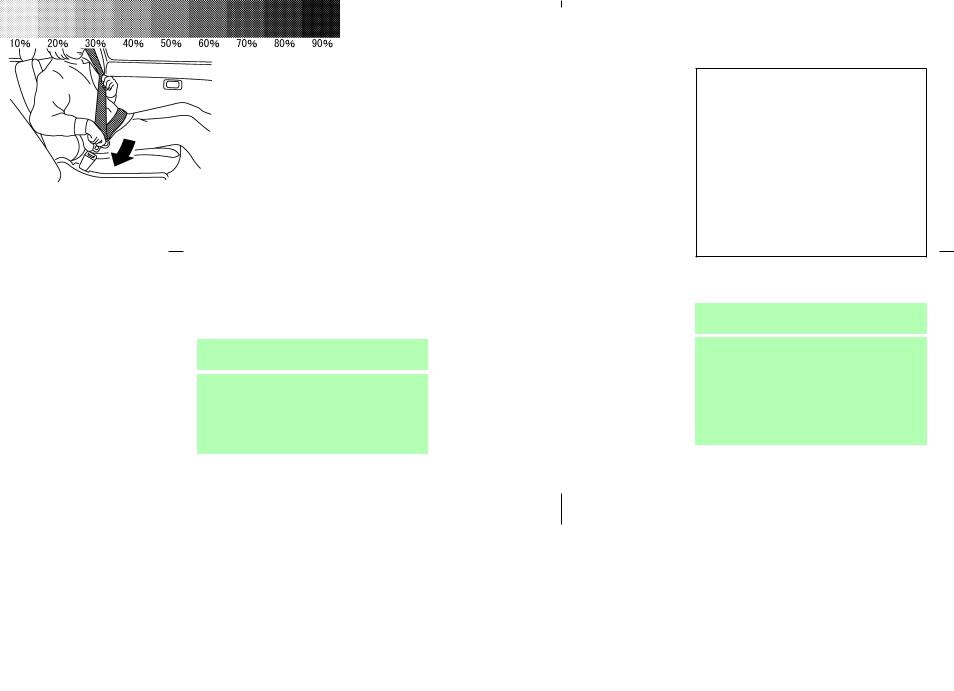
feet 9 inches) tall and weighs between 18 kg (40 lbs) and 36 kg (80 lbs). A booster seat should be used to obtain proper seat belt fit.
NISSAN recommends that a child be placed in a commercially available booster seat if the shoulder belt in the child’s seating position fits close to the face or neck or if the lap portion of the seat belt goes across the abdomen. The booster seat should raise the child so that the shoulder belt is properly positioned across the top, middle portion of the shoulder and the lap belt is low on the hips. A booster seat can only be used in seating positions that have a three-point type seat belt. The booster seat should fit the vehicle seat and have a label certifying that it complies with Federal Motor Vehicle Safety Standards or Canadian Motor Vehicle Safety Standards. Once the child has grown so the shoulder belt is no longer on or near the face and neck, use the shoulder belt without the booster seat.
 WARNING
WARNING
Never let a child stand or kneel on any seat and do not allow a child in the cargo areas while the vehicle is moving. The child could be seriously injured or killed in an accident or sudden stop.
PREGNANT WOMEN
NISSAN recommends that pregnant women use seat belts. The seat belt should be worn snug, and always position the lap belt as low as possible around the hips, not the waist. Place the shoulder belt over your shoulder and across your chest. Never run the lap/shoulder belt over your abdominal area. Contact your doctor for specific recommendations.
INJURED PERSONS
NISSAN recommends that injured persons use seat belts, depending on the injury. Check with your doctor for specific recommendations.
SSS0292
Front seat
THREE-POINT TYPE SEAT BELT WITH RETRACTOR
 WARNING
WARNING
Every person who drives or rides in this vehicle should use a seat belt at all times.
Do not ride in a moving vehicle when the seatback is reclined. This can be dangerous. The shoulder belt will not be against your body. In an accident
Safety — Seats, seat belts and supplemental restraint system 1-15
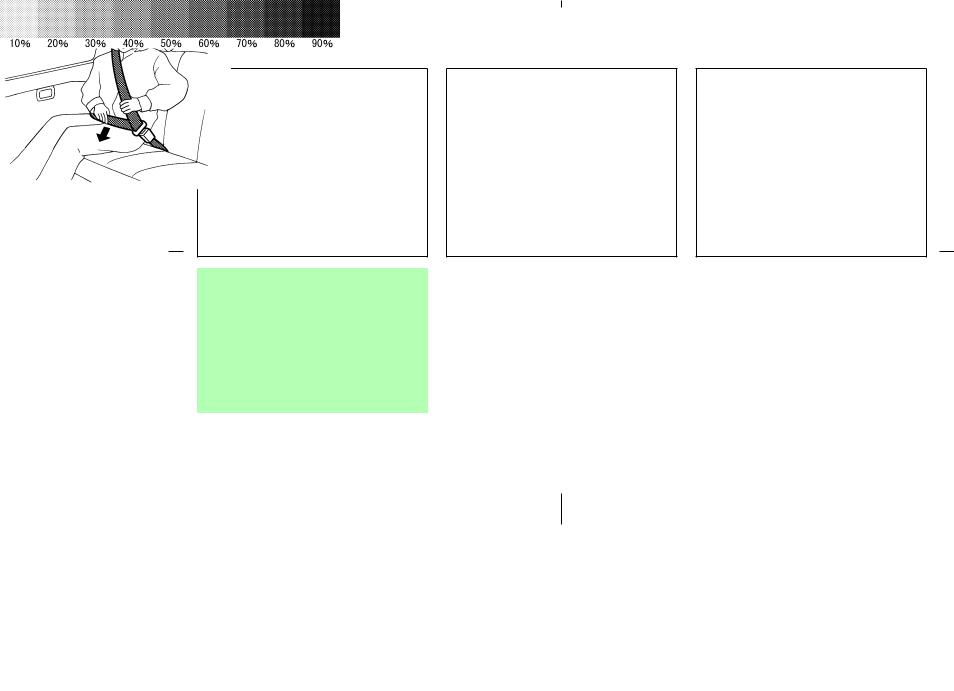
SSS0290
Front seat
you could be thrown into it and receive neck or other serious injuries. You could also slide under the lap belt and receive serious internal injuries.
For most effective protection when the vehicle is in motion, the seat should be upright. Always sit well back in the seat and adjust the seat belt properly.
SSS0293
Rear seat
Fastening the seat belts
1.Adjust the seat. See “Seats” earlier in this section.
2.Slowly pull the seat belt out of the retractor and insert the tongue into the buckle until it snaps. For additional information regarding the rear center seat belt, see “Rear center seat belt” later in this section.
The retractor is designed to lock during a sudden stop or on impact. A slow pulling motion will permit the belt to move, and allow you some freedom of movement in the seat.
1-16 Safety — Seats, seat belts and supplemental restraint system
SSS0291A
Rear seat
If the seat belt cannot be pulled from its fully retracted position, firmly pull the belt and release it. Then smoothly pull the belt out of the retractor.
3.Position the lap belt portion low and snug on the hips as shown.
4.Pull the shoulder belt portion toward the retractor to take up extra slack. Make sure the shoulder belt is routed over your shoulder and across your chest.
The front passenger and rear seat belts have a locking mechanism for child restraint installation. It is referred to as the automatic locking mode.
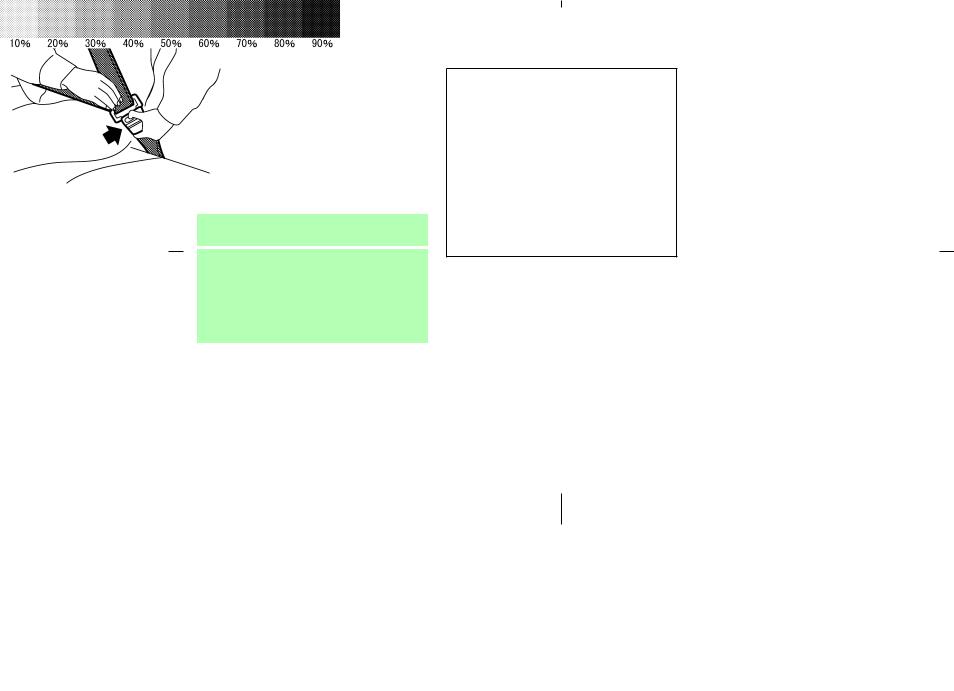
When the locking mechanism is activated the seat belt cannot be extended again until the seat belt tongue is detached from the buckle and fully retracted. For additional information, see “Child restraints” later in this section.
The automatic locking mode should be used only for child restraint installation. During normal seat belt use by a passenger, the locking mode should not be activated. If it is activated it may cause uncomfortable seat belt tension.
 WARNING
WARNING
When fastening the seat belts, be certain that seatbacks are completely secured in the latched position. If they are not completely secured, passengers may be injured in an accident or sudden stop.
ward. The retractor should lock and restrict further belt movement.
If the retractor does not lock during this check or if you have any questions about belt operation, see a NISSAN dealer.
SSS0326
Unfastening the seat belts
To unfasten the belt, press the button on the buckle. The seat belt will automatically retract.
Checking seat belt operation
Your seat belt retractors are designed to lock belt movement using two separate methods:
when the belt is pulled quickly from the retractor.
when the vehicle slows down rapidly.
You can check their operation as follows:
grasp the shoulder belt and pull quickly for-
Safety — Seats, seat belts and supplemental restraint system 1-17
